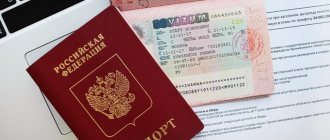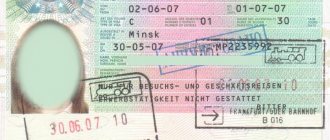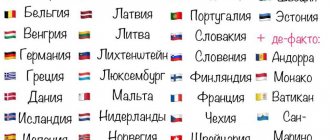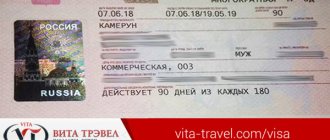It’s possible to complete and submit documents once, and then travel around Europe unhindered for five years. A Schengen multiple visa valid for five years is increasingly being issued to our compatriots who actively visit European countries. Getting greater freedom of movement, it is necessary to more carefully monitor compliance with visa rules, so as not to violate legal requirements and not get on the Schengen blacklist.
Map of Schengen countries
Schengen multiple visa or travel as a way of life
Tourists, especially beginners, are very frightened by the process of obtaining permits to enter the countries participating in the Schengen Agreement. An unfamiliar procedure, many nuances, strictness of consulate staff. But at the same time, the Schengen multivisa is the most cherished, but also the most unattainable dream of everyone who is in love with Europe and travel.
The process is complicated by the fact that it can be obtained at almost any consular department of each of the 26 countries party to the agreement. It is the huge choice that becomes the stumbling block. Many questions arise: which country should you choose for processing documents, how to use a visa correctly, what restrictions exist.
Some European Union countries issue multiple visas for 2 years to almost every tourist, while some can only issue a visa for the duration of the trip, for example, 30 days. The situation is heated by constant changes in visa legislation. 2021 will not be an exception for Russians.
What is a multiple visa and a regular visa?
Such a document with the prefix “multi” is especially useful for people who:
- go on business trips;
- visit relatives living abroad;
- studying at a foreign university;
- undergo serious treatment in sanatoriums;
- they just like to relax often.
Obtaining a multiple visa is not always justified - sometimes it is easier and more profitable to apply for a regular visa several times. Let's figure out what is usually meant by the term “multiple visa” and when it is irreplaceable, as well as how to draw up this document.
So, various visas allow travelers to travel around the world under special conditions. However, what rules and benefits are established for those who travel abroad especially often? And in general, a single-entry visa - what is it and why is it less profitable?
Before talking about the difference between concepts, you should understand what a single-entry visa is. As you can guess from the name, this document gives the right to enter any country once; in the case of Schengen territories, visit several European countries at once, the main thing is to first live a little in the state that granted you permission to travel.
However, once you are in your home country, the overseas pass will no longer be valid. This rule is observed even if the visa period has not yet expired, and out of the allowed thirty days you have stayed abroad for only a few days.
In general, everything is simple and clear; But what a multiple-entry visa is is somewhat more complicated and interesting. Such a document (which is otherwise called a multiple visa) gives the right to visit the same state several times - or, if we are talking about a Schengen visa, to repeatedly enter the agreement area through this country. Of course, a multiple entry visa has a certain validity period; a multiple document can operate:
- six months;
- year;
- two years;
- three years;
- five years.
It should be remembered that such visas are issued in stages: for example, most countries participating in the Schengen agreement issue a multiple-entry visa first for a period of 90 days, and only then for six months, a year, etc.
However, if you have received a multiple visa, this does not mean at all that you can almost settle in the territory of another country. The Immigration Service sets a limit - how many days out of all allowed days you can spend abroad. Usually it's 45 for 3 months; 90 days within six months; 180 days during the year. The features of the system will be discussed below, but for now let’s consider another type of permit - a double-entry visa.
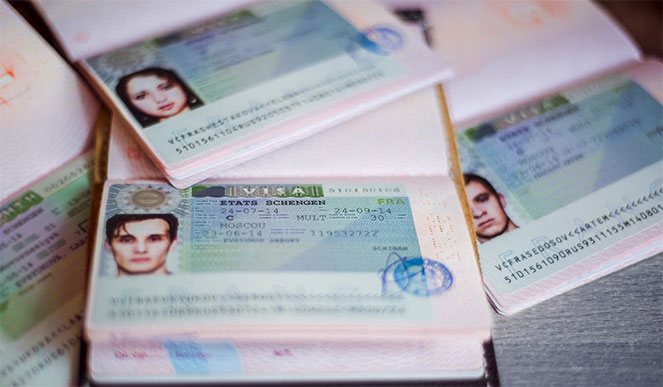
There is no need to explain for a long time what a “double-entry visa” means. As you might guess, such a stamp in a foreign passport will allow you to visit the same country twice. However, please note that the period of stay abroad with such a document may be limited.
Visa frequency
To classify the types of permits, immigration officials and travel agencies use the term “visa multiplicity”: this is the number of permitted trips abroad with one stamp. Thus, visas are divided into those already described above:
- one-time;
- double;
- multiple (unlimited number of trips, the main condition is compliance with deadlines).
There is also such a thing as the multiplicity of the requested visa; what this is becomes clear when preparing documents for departure. This value should be reported to the consulate so that they provide you with exactly the document you want. In addition, the visa number must be indicated in the invitation if you have been called abroad on business.
Multiple visa - multiple possibilities
Obtaining a Schengen multiple visa is the dream of every tourist who loves to vacation in Europe. Multiple entries, the possibility of frequent trips without issuing a separate visa for each, as well as time saved - all this is provided by a Schengen visa with the coveted “MULT” inscription.
The Schengen multiple entry visa is often confused with a national visa or residence permit due to its long validity period. But in fact, a multiple visa is a regular Schengen visa of category C, which every tourist applies for to travel to the countries of the European Union. Despite its long period, there are restrictions on the number of days allowed for stay in the European Union.
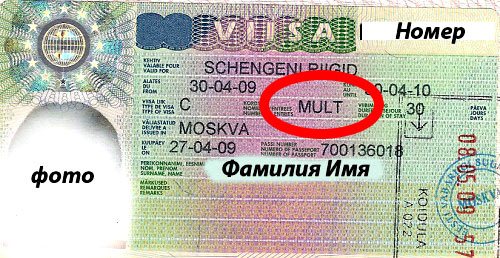
A multiple visa gives the right to multiple entries into the territory of the European Union. It is up to the tourist to decide whether to come once for 90 days or 10 times for 9 days. While a single-entry visa will allow you to enter Europe only once, travel around neighboring countries for the amount of time indicated on the visa, and return home.
It will no longer be possible to re-enter Schengen territory using this document. Even the fact that out of the 30 days that the visa is valid, you spent only a few days abroad will not be an argument. That's why it's a one-time thing.
It is also worth noting that a multiple visa does not give the right to work and study, and it cannot be extended while directly in the EU.
Which countries can you enter with a valid Schengen visa as of August 2018?
Albania requires a category of Schengen visas - multiple C, national D or residence permit. You are allowed to stay in the country within the validity period of the visa, but not more than 90 days1 in 180 days. The visa must be used at least once to enter Schengen. Bulgaria double or multiple C, national D, residence permit; the period of stay is determined in accordance with that specified in the Schengen visa, but not more than 90 days in every 180 days. Bonaire 30 days if you have a multiple visa C or 90 days if you have a residence permit/permanent residence permit. Gibraltar multiple entry C; length of stay - up to 21 days. If the Schengen visa is valid for less than 21 days at the time of entry into Gibraltar, the period of stay is calculated as follows: the remaining validity of the Schengen visa minus 7 days. Cyprus Double and multiple C, the visa must be used at least once to enter Schengen. Entry with a single-entry visa is also possible, but in this case you need to enter only from Schengen territory. Duration of stay - in accordance with that specified in the visa. Curacao 30 days if you have multiple visas C or national D Reunion if there is an entry “also valid for Reunion” in the French visa sticker Romania double or multiple entry C, residence permit; the period of stay is determined in accordance with that specified in the Schengen visa, but not more than 90 days in every 180 days. Sint Maarten multiple C, national D and residence permit. The period of stay for holders of C and D is 30 days, for holders of a residence permit - 90 days. Saint Barthelemy - residence permit, French Schengen visa category C valid for at least 6 months (no matter how much is left before the end of this period, but the visa sticker is required entry “also valid for SB or DFA”), national D of any Schengen country valid for at least 6 months and with a permitted stay of at least 90 days. If you have any of these visas, you can stay on the territory of St. Barthelemy for no more than 90 days within 180 days. French Guiana, if there is an entry in the French visa sticker “also valid for French Guiana” Croatia double or multiple C, national D, residence permit; the period of stay is determined in accordance with that specified in the Schengen visa, but not more than 90 days in every 180 days.Validity period of the Schengen multiple visa
Today there are several urgent multivisas:
- up to 3 months
- for 6 months;
- for 1 year;
- for 2 years;
- for 5 years.
However, this does not mean that a Schengen holder will be able to enter the zone once and stay there continuously for that entire time. Each visa issued, in addition to the period for which it is issued, has a certain number of days that the holder can spend abroad every six months. Usually 45 and 90 days are indicated for every 180.
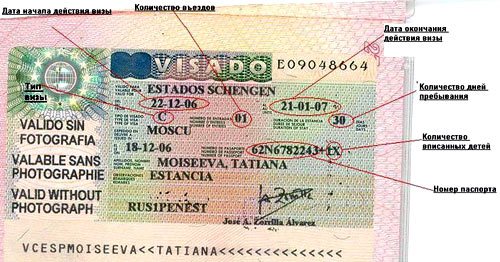
Designations on a Schengen visa
The rules for counting days spent on the territory of participating countries have changed, and in 2021 they will operate according to the following scheme.
- The date of visa issuance is the date of actual receipt of the document in hand at the consular section of the embassy. It is neither the visa opening date nor the beginning of the semester. As a rule, several months are given before the immediate activation of a Schengen multiple visa.
- The first border crossing and receipt of the first entry stamp is the visa activation date. The countdown of the first half of the year begins with it. This period is in no way tied to the traditional calendar division. Each traveler has a different six-month period.
- If the visa is valid for 2 years, and the number 90 is indicated on the card itself, this means that every six months for two years, you have the right to spend 90 days abroad.
- The date of first entry and the date of first exit from the Schengen zone determine the boundaries of the first time period. There can be quite a lot of such segments. Adding them up for the entire period of validity of the visa, you will get the number of days spent abroad. Those same 45 or 90 days.
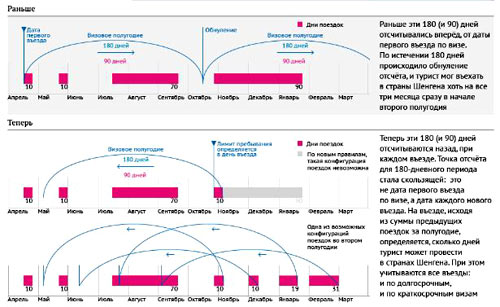
- If the limit on the number of days has been exhausted, but the visa is not yet valid, you still cannot use it. Even if they don’t notice this when crossing the border and put the necessary stamps, then when you receive the next multiple visa to Europe you will have serious problems: it may not be issued to you at all for the next 10 years. Therefore, it is in the interests of the tourist to independently and very carefully monitor the number of days used on a multivisa. For this purpose, various services have been invented, including visa calculators.
- Sometimes it is necessary to calculate how many days in the Schengen zone were spent in a certain country. To do this, use the dates on stamps directly from the country that needs to be tracked.
The rules for counting days have changed somewhat; this had to be done in order to remove a loophole in the law that allowed tourists to spend six months continuously abroad while holding an annual multiple visa.
Rules for staying in Schengen with a multiple visa
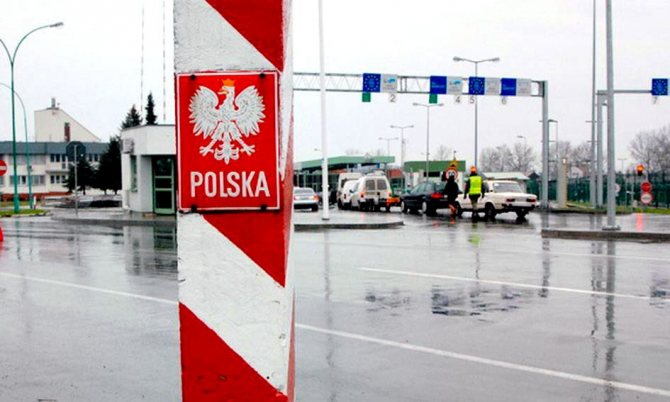
A multiple visa allows you to freely visit 26 countries of the Schengen Union. Using the multi-resolution capabilities requires following certain guidelines. The rules for entering the Schengen area with a multiple visa are generally similar to short-term ones, but in order to guarantee subsequent loyalty to yourself, you should adhere to them:
- Submit documents to the representative office of the country in which you plan to spend the maximum amount of time. If it is not possible to determine the main location point, then they turn to the first state on the route.
- Strictly adhere to the 90-day deadline. To do this, you can keep an electronic diary, summing up the amount of time spent abroad from the moment you crossed it.
- Avoid even administrative offenses (smoking in undesignated places, illegal parking);
- First crossing rule. It means that it is advisable to make your first entry into the country that allows travel.
- When visiting several countries, spend the maximum number of days in the country that issued the permit. Some travelers recommend opening a visa at more loyal consulates, but you also cannot forget about the need to pay more attention to this country when planning your route.
A Schengen multiple visa is an excellent alternative to a residence permit if you have property or relatives abroad. However, this is unlikely to serve as a prerequisite for going for permanent residence. And the possibility of getting confused with the period of stay is also quite real.
Who can get multi Schengen
Travelers with experience have the best chance of getting the coveted sticker in their foreign passport, this is exactly what multi-Schengen looks like.

The more experience and impeccable visa history, the greater the chances. Those who are going abroad for the first time and immediately plan to apply for a multiple visa to Europe should prepare for refusal, since the chances are, objectively, minimal. But since they don’t charge extra money for the “multiple entry” checkbox on the application form, and if you refuse to issue a multiple entry visa, they will give you a short-term tourist visa, it’s worth trying your luck.
It will be easiest for tourists who have not only been abroad, but also visited Europe or other Schengen countries. And the more such visits there were, the higher the likelihood of receiving a multiple visa. In this case, it is not the duration of the trips that matters, but their number.
It is also easier to obtain a Schengen multiple visa for those who traveled on single-entry tourist visas to any countries participating in the agreement.
Having a history of receiving simple visas, you can already try to apply for a “cartoon”. Moreover, this should be done in stages. First for a short period of time, after its expiration - for a longer period.
It is also worth noting that not all countries are willing to provide multiple visas. For example, Austria and Germany are very strict about issuing multi-Schengen visas and usually issue short visas for 1-3 months. But some countries are more loyal to tourists.
These include:
- France;
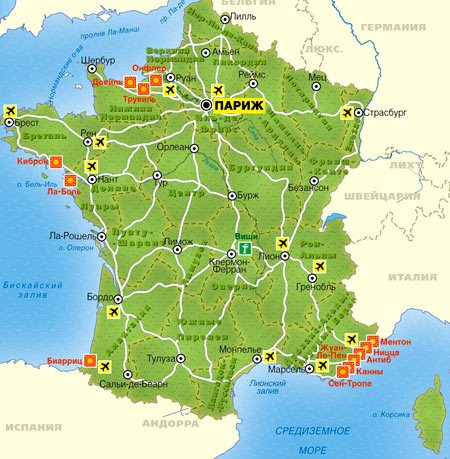
- Italy;
- Spain;
- Slovakia;
- Greece;
- Finland.
Some are interested in developing business relations with Russia, others are interested in the tourist flow from our country, and others simply make money by issuing visas to almost everyone. Therefore, the likelihood that a newcomer to the travel industry will be able to obtain a multiple visa is higher.
There is a multiple visa: countries you can visit
The Schengen zone is an association of 26 European countries. In terms of international travel, it operates much like a single state, with border controls on the external border - when entering and leaving the zone - but no border controls on the internal borders of the states that are included in the zone.
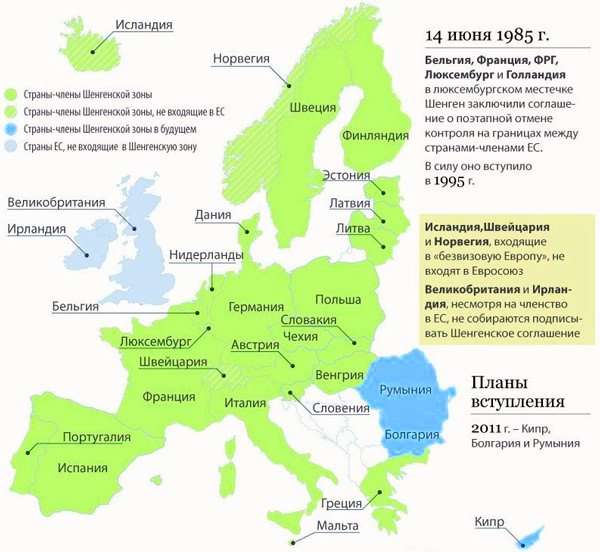
Remember that your stay in the country is not limited. The number of days that you have the total right to spend within the Schengen zone within a certain time period is limited. The first day of stay is considered the day of entry, and the last day of stay is the day of departure. It is enough to exceed the norm by one day, and you become a violator of the visa regime at the border: deportation and an entry ban stamp await you.
Documents for obtaining Schengen
Each country that issues a multiple visa requires you to provide its own set of documents. Despite some differences, additions and nuances, in general these lists are similar. Here is an approximate list that will allow you to form a general idea of what papers will have to be completed:
- A foreign passport, and its validity period must overlap the period of stay in the country by three months;
- Copies of pages of the passport of a citizen of the Russian Federation, which contain personal information, registration, information about marital status;
- Information about previously obtained visas up to the provision of an old passport. This is not a mandatory item, since the passport is confiscated upon expiration. But if you have copies, you should take them with you to your appointment at the embassy or visa center;
- Color photographs size 35*45 mm;
- Information about you from your place of work, including a certificate that should contain comprehensive information about the employing company and you as an employee;
- Certificate of solvency. The amount depends on how many days you plan to stay abroad. Each day is valued at 50 euros;
- Providing guarantees that you plan to return to Russia. Any documents are suitable for this, and the more the better, which will provide information about what is keeping you here: family connections, real estate, and other evidence;
- Medical insurance for travelers abroad. It must be valid for the period that you plan to stay in the Schengen countries. The minimum amount of coverage is 30,000 euros;
- Copies of round-trip air tickets or confirmed reservation. Originals will also be needed, but they can be provided later;
- 35 euros to pay the consular fee.
- Visa application form.
It is the last point that should be given special attention, since the success of the entire operation depends on the correct filling of some fields. To be sure of what information and how to write in these fields, it is better to contact the visa center for clarification.
The main requirement is that all information must be reliable.
When contacting travel agencies or companies specializing in preparing documents for obtaining a visa, the cost of their services can amount to thousands of euros. It depends on the country issuing the document and its validity period. At the same time, the amount of the consular fee will be tens of times less, in the range of 100-200 euros.

What is this?
Multiple Schengen visa: what is it? In essence, this is an ordinary visa that gives the opportunity to cross the borders of the Schengen zone states and stay in them for a certain period of time. The peculiarity of a multiple visa is that it allows you to enter the Schengen countries more than once, even every day.
Today, Russians are issued Schengen multiple-entry visas for 6 months, 1, 2, 3 and 5 years. Staying in Europe is allowed only during a strictly designated period. In addition to the validity period, there is also a limitation on the maximum number of days of stay. Usually it is no more than 45 or 90 days in one half-year.
Rules and procedure for use
There are 26 Schengen member countries, and the coveted visa can be obtained only at one representative office. This raises a number of questions, including how to choose the right state in which to apply for documents, in what order to visit the selected countries, and how long to stay in each of them.
These are quite reasonable clarifications, since even a single violation of the visa regime in the future may result in a ten-year quarantine. In order not to fall into a trap, or rather, not to set it up for yourself with your own hands, you need to have complete information.
Which countries are easier to issue a multiple Schengen visa?
Among the countries, we can highlight those that easily issue a multiple Schengen visa for six months or more, while there are those that provide a visa only for the dates of the trip. In reviews, tourists mention Spain, Italy, France, Greece as countries with the most favorable visa regime. The embassies of these countries are more willing to issue long-term visas. I received my first Schengen in my life in Spain. I didn’t expect it, but I got the cartoon for six months. When I applied for a visa for the second time, the Spaniards gave me a visa for a year. But some of my friends were given a three-year multiple visa by the Greeks, and others by the French. The worst countries to issue visas are Germany, the Czech Republic, and the Baltic countries. You definitely won’t get it for six months the first time. But even with such knowledge, you cannot obtain a visa to one of these countries if you do not plan to visit it. These countries have many interesting places and beautiful resorts, so it is better to choose one of them for your first trip. And then, having become the holder of a Schengen multivisa, you can travel throughout Europe for several years.
Now you know what a Schengen multiple visa is and what its main advantages are. I am sure that obtaining this type of visa will not be difficult for you, which means that the path to frequent trips will be free of restrictions.
Have a nice travel
About the author: Ekaterina
On the pages of my blog you will find information about the places I have been, secrets and life hacks of independent travel.
- Related Posts
- How to get a Schengen visa yourself
- How to book flights online without paying for a visa?
- Sponsorship letter for a Schengen visa: sample in Russian and English
Provided by SendPulse
« Previous entry
In which country should a multiple visa be obtained?
If we discard the principle “where is it easier”, then the rules state that you need to apply for a document in the “main country of the Schengen zone”. This refers to the state where you plan to spend the most days during the validity of your multiple visa. Also, instead of days, you can count the number of entries.
In this case, it will not matter at all which countries, other than the main one, you visited and how many times, if the above parameters regarding the main state that issued the visa are met.
Often, when closing a visa, border guards can actually count the number of days and the number of entries, and if you do not meet the requirements, ask you a few questions, cancel your visa and put you on a blacklist that will not allow you to become a Schengen holder again.
Types of Schengen visa
The type of multiple entry visa depends on the reason why you intend to come to a Schengen country. In total, the following varieties are distinguished:
- Tourist;
- Guest room;
- Working.
Each type of Schengen visa is issued differently, and is issued under specific conditions. To obtain a visa to stay in the Schengen countries for the purpose of tourism and study, you will need a different package of documents, so you need to prepare carefully. It doesn’t matter why you decided to get a Schengen multiple visa, you still have to prove that you need it.
To obtain a multiple-entry visitor visa, an application from the inviting party will be required. It will also be required if you are leaving to work in one of the Schengen states. The employer must take care of the invitation. In other cases, you do not need to provide any special documents.
First entry rule
Valid only if you apply for a visa to the state through which you plan to enter, and then spend the same number of days in all the countries you will visit. Otherwise, this rule does not apply.
For example, when receiving a Schengen multiple visa for Spain, it is not necessary to start your journey with it.
It’s enough just to spend a couple of days more on its territory during your vacation than in the other countries on your route. As a rule, the rule only applies if the periods of stay in the countries are equal. In simple terms, it doesn’t matter which country you entered through, what matters is where you spent the most time.

When traveling around Europe by car and with stops of the same duration in each country, it is better to use a visa with the right of first entry and draw up the document at the representative office of the country where you will cross the border for the first time.
Also, do not forget that in the visa application form you can indicate the country of first entry and provide tickets to the country of primary destination.
Schengen multiple visa: what is it?
If you often visit Schengen countries, then obtaining a multiple visa is a must. It will help you save time and money on organizing your trip. If you have a multivisa in your passport, you no longer need to wonder whether they will give you a visa and therefore miss out on tempting tickets and tours. After all, you must agree that in order to get favorable prices, you need to make a decision with lightning speed. Absence often becomes a hindrance in travel. I myself have encountered this many times and missed out on profitable offers. No, I had no doubt that they would give me a visa, but it takes at least a week to prepare documents and process it, and last-minute offers usually appear with departure in 2-3 days. So you have to look at such proposals and regret the missed opportunities.
A Schengen multiple visa is a type of visa that allows you to enter the territory of the Schengen countries an unlimited number of times within the specified period.
Let's look at a practical example of what this means.
Imagine that you did everything right, collected a complete set of documents for a Schengen visa, which in the eyes of the consul formed an opinion of you as a respectable citizen with the necessary amount of funds for travel. In response to this, the consulate issued you a multiple visa for 1 year with the right to stay no more than 90 days every six months. What does it mean? This means that during the year you can visit Schengen countries and even live in them, but no more than 90 days every six months. You can, for example, live in Prague for a month, in Berlin for a month, and then return to your native Moscow and go to Riga or Vilnius for the weekend. That is, no one will take into account how many times you entered Schengen, but they will take into account how much time you spent there. I advise you not to violate the visa regime and carefully calculate the number of days spent in the Schengen zone, so as not to have visa difficulties in the future. Thus, once you have collected the documents for a Schengen multiple visa, you will receive maximum freedom of travel in many European countries.
Even if you travel 2-3 times a year, a multiple visa is much more profitable than a single visa, because no one likes to waste time visiting the embassy and collecting papers. That’s why any tourist is so happy when he is given a visa for a year or more. Can you imagine if you won’t have to think about paperwork for 3 or 5 years? In addition, each Schengen visa means additional travel costs. The cost of one visa is now 35 euros. Moreover, it does not matter at all for what period it was issued - for a week or for a year. The price of a Schengen multiple visa does not change depending on the period. It places a heavy burden on one trip, increasing its cost. But if you stretch it over several trips, receiving a multiple visa for three years, then these costs become less noticeable. When organizing a trip, and especially before submitting documents, do not forget to take out medical insurance for all days of your stay in the Schengen zone.
A multiple visa allows you to visit any Schengen country. For example, Spain issued you a three-year multivisa, but with it you can travel to the Czech Republic, Germany, France and all other Schengen countries. Previously, the rule of first entry was in effect, that is, you first had to obtain a visa to the country where you crossed the Schengen zone. You are planning to vacation in Spain, but fly through Berlin and get a German visa. After all, it is in Germany that you will get a stamp in your passport about crossing the border. And when flying from Germany to Spain there are no checks. But now on the websites of all visa centers and consulates of the Schengen countries it is stated that a visa must be obtained for the country where you are going to spend the most time. In our example, with a flight to Spain via Berlin, you should apply for a visa to Spain. You confirm your stay in this country by booking a hotel.
Fulfilling visa obligations
In visa matters, honesty is one of the principles that should be followed. Or lie, but very skillfully, with the provision of all kinds of supporting documents.
Such cheap tricks as booking hotel rooms and canceling them after receiving a visa will not work, since the information will certainly end up in the representative office of the country where you received the Schengen visa, and, of course, the next time you apply, you are unlikely to get a positive result solution.

But there are still some tricks, tricks and little tricks. Developed over the years and the practice of hundreds of tourists, they help increase the chances of obtaining a Schengen multiple visa.
- You can prove the need to obtain a multiple visa by providing information about your own previously made trips to the country whose consulate you are applying for the document. This could be air tickets, hotel reservations, papers from work confirming frequent business trips.
- Using the first issued visa in full, that is, all 90 days out of a possible 90 in six months, will make it much easier to obtain the next multiple visa for a longer period.
- When entering Schengen territory other than through the state that issued the visa document, you need to come up with compelling reasons for your action. These can be both excuses and very real reasons. A business trip, participation in a symposium or exhibition, tickets to fly to the main country - most often anything will do.
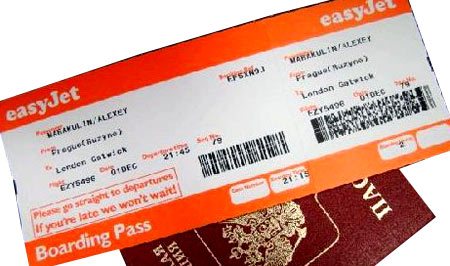
- A very powerful argument in obtaining a Schengen multiple visa will be the use of an invitation from business partners or relatives, acquaintances, or friends who live abroad.
Conclusions TheDifference.ru
- A regular visa is a broader concept than a multiple visa, which is one of the types of a regular visa, distinguished by the number of visits to the country over a certain period.
- A multiple visa is a priori multiple entry phenomenon, while a regular visa can be single or multiple entries.
- A multiple entry visa gives the right to multiple entries into the territory of a particular country or union of countries, while a regular visa can guarantee one, two or multiple entries.
- It is a little more difficult to obtain a multiple entry visa to the EU countries than a single entry permit.
